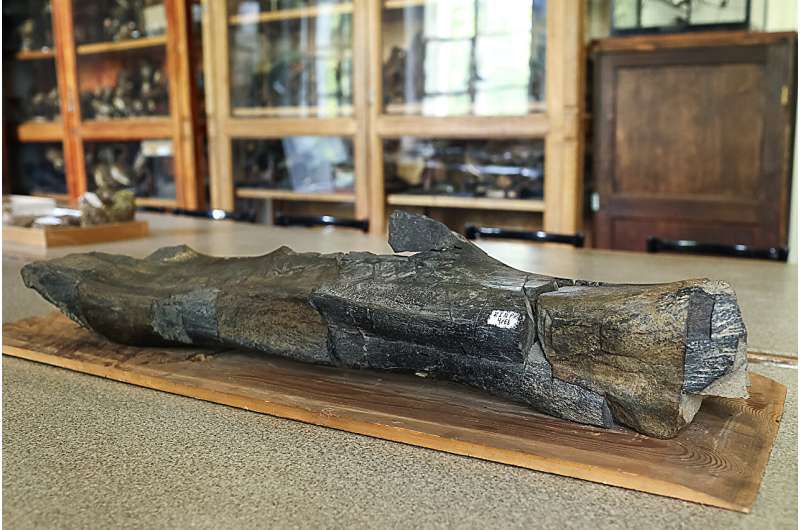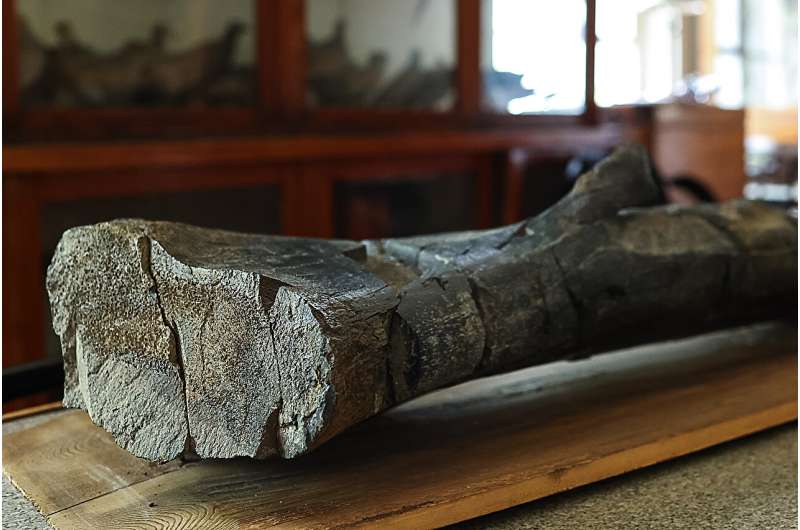This article has been reviewed according to Science X's editorial process and policies. Editors have highlighted the following attributes while ensuring the content's credibility:
fact-checked
peer-reviewed publication
trusted source
proofread
Paleontologists study dinosaur fossils to confirm that Chukotka, Russia, had a milder climate in ancient times

Scientists from St Petersburg University as part of a research team have studied bones of hadrosaurid dinosaurs, or duck-billed dinosaurs, found in Chukotka. They were able to confirm that 66 million years ago the climate in the area was much milder than what had been previously believed.
The authors of the study are Professor Pavel Skutchas, Acting Head of the Department of Vertebrate Zoology at St Petersburg University; and Roman Bapinaev, a master's student at St Petersburg University. They spoke in detail about the research at the St Petersburg University Science Lunch, which has recently been published in th journal Cretaceous Research.
Fossils of polar hadrosaurid dinosaurs from the Upper Cretaceous period (about 66 million years ago) were found at the Kakanaut locality in Chukotka, Russia, by the 2009 expedition of the Komarov Botanical Institute of the Russian Academy of Sciences. In 2014, the fossils—two femur bones, almost a meter-long each; vertebrae; proximal fragments of a humerus; and a scapula—were handed over to the experts from the Department of Vertebrate Zoology at St Petersburg University for further research.
At the same time, the paleobotanists from the Komarov Botanical Institute reconstructed the plant component of the ancient ecosystem of the area. They established that the climate in Chukotka in the Late Cretaceous period must have been much milder than now, with the average temperature about +12°C. The paleontologists from St Petersburg University, for their part, conducted an in-depth study of the hadrosaur fossils using the paleohistology method.
"We prepared thin sections of the hadrosaur bones and examined their structure and composition. This enabled us to evaluate the dynamics of bone growth. We expected to see specific features typical for dinosaurs that lived in harsher environments, such as found in polar dinosaurs from Alaska. The bones under study, however, did not show such features. On the contrary, we found convincing evidence of a mild climate," said Pavel Skutchas, Acting Head of the Department of Vertebrate Zoology at St Petersburg University.
"In particular, we expected to reveal the lines of arrested growth, which result from pauses in the rate of bone deposition. It can be compared with annual growth rings in trees that result from the change in growth speed through the seasons of the year. Visible rings are formed only in winter, marking the passage of one year in the life of the tree; hence, they are used to calculate the age of the tree.
"The lines of arrested growth are not present in the Chukotka dinosaur bones. This indicates continuous growth, which would have been impossible in harsh conditions."

According to the paleontologists, polar dinosaurs could have theoretically avoided unfavorable climate conditions (such as the polar night) by migrating southward every year. However, the long-distance migration causes stress on the organism, which must be reflected in the bone structure.
Apart from lines of arrested growth, a harsh climate could have been evidenced by interlayers of less densely vascularized bone tissue. None of these features were found in the fossils. Furthermore, fossilized dinosaur eggs were also found in the Kakanaut Formation. This is an evidence of ancient Chukotka being their breeding area, which contradicts the migration hypothesis, since migration would have been impossible with active breeding.
"We hypothesize that such a drastic difference in climate over time can be explained by the presence of a warm current 66 million years ago. It can be compared to the British Isles that lie at about the same latitude as Kamchatka, just below the latitude of Chukotka; yet, the climate in Britain is much milder thanks to the warm waters of the Gulf Stream. Similar natural phenomena might have been present in the Upper Cretaceous period in Chukotka," explained Roman Bapinaev, a master's student at St Petersburg University.
More information: Roman A. Bapinaev et al, New data on high-latitude hadrosaurid dinosaurs from the Upper Cretaceous Kakanaut Formation of Chukotka, Russia, Cretaceous Research (2023). DOI: 10.1016/j.cretres.2023.105552
Journal information: Cretaceous Research
Provided by St. Petersburg State University




















